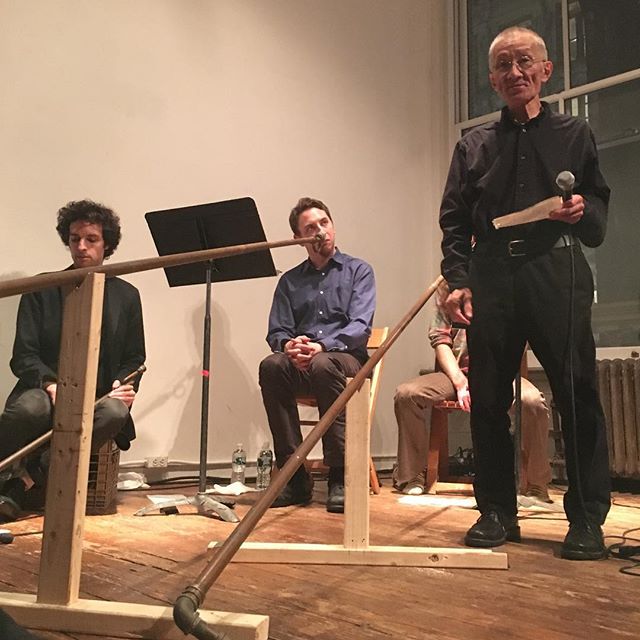Horns
The Handmade Horns and Drone Music of a Fluxus Composer

Yoshi Wada introducing “Earth Horns with Electronic Drone” at the Emily Harvey
Foundation (photo by @thehouseofdis/Instagram)
Foundation (photo by @thehouseofdis/Instagram)
Tashi Wada, Yoshi’s son and an accomplished composer in his own right, kickstarted the performance with a mid-frequency hum generated by an organ. After a few minutes, two short, higher-pitched horns entered the mix. The players held the notes interminably, with subtle differences in pitch prompting a rhythmic pattern that felt embedded into the surfaces of the room. Then two larger horns — each roughly 20 feet long, stretching across the floor — entered, one providing an impossibly deep backbone to the existing swirl of sounds, the other punctuating the dense composition with shorter, slightly higher moans. Once each instrument had been introduced, they began to cycle in and out according to Wada’s diagrammatic score, in a way that kept the sound in constant yet nearly negligible flux — wavering and shifting second by second in microscopic increments. Calm but never silent (indeed, often quite loud), Wada and his cohorts breathed — or rather, blew — organic life into calculated minimal music that could, in the hands of lesser musicians, be a bit “boring.”
Wada’s approach to drone music, like that of many of his contemporaries, draws inspiration from, on the one hand, various musical traditions of east and south Asia, and on the other, the post–John Cage American avant-garde. (Wada notably studied Scottish bagpipe music as well.) Born in Japan but based in the United States for nearly 50 years, Wada rose to prominence in the late 1960s as a member of the international art collective Fluxus. By the time he composed “Earth Horns,” drone music had represented the crux of the Fluxus musical practice for several years. The collective’s best-known composer at the time, La Monte Young, proffered a brand of drone based on pitch ratios that, in his view, had been reverberating throughout the cosmos since the beginning of time. As if to drive this notion home, Young called his group the Theatre of Eternal Music. Wada and Young’s Fluxus associations (as well as their mutual kinship with the great Hindustani vocalist Pandit Pran Nath) might suggest that the two composers share similar approaches to drone. But Wada’s performance at Emily Harvey made it clear — if the title, “Earth Horns,” hadn’t already — that he and Young ultimately exist in different realms: one terrestrial, one extra-. Young’s perpetual installation “Dream House,” for example, on display this summer at Dia:Chelsea and otherwise in Tribeca, prods visitors toward transcendence with bright purple lights, images of eastern spiritual leaders, an imperative to take off your shoes because of the carpeted floor, and above all, humming drone music playing from speakers hung near the ceiling.

0 Comments:
Post a Comment
<< Home